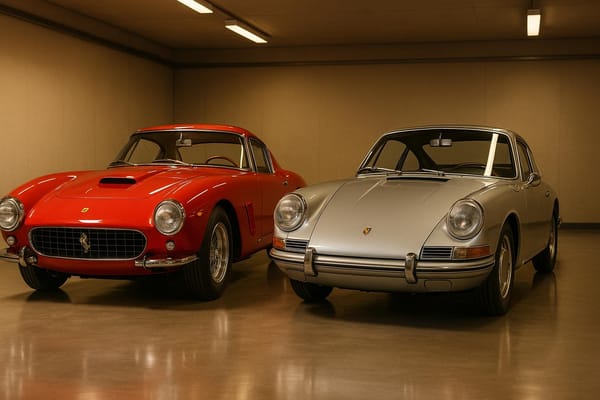How Historical Significance Impacts Car Investments
Historic cars can be valuable investments, with their worth influenced by factors like rarity, provenance, and market trends.

Historic cars can be a smart investment, but their value depends heavily on their backstory. Cars with a rich history, rare features, or connections to motorsport or pop culture often see their prices rise over time. Here's a quick summary:
-
What Adds Value?
- Original factory documents (build sheets, delivery records).
- Racing achievements or celebrity ownership.
- Rare models or limited production runs.
- Groundbreaking technologies or designs.
-
Who Buys Them?
- Collectors who preserve cars long-term.
- Investors balancing heritage and market trends.
- Enthusiasts focused on specific brands or eras.
-
Key Trends:
- Cars from the 1980s and 1990s are gaining popularity.
- Brands like Ferrari, Aston Martin, and Porsche hold their value well.
-
What to Check Before Buying:
- Verify all documents (build sheets, service history, ownership records).
- Confirm original parts like engine and chassis numbers.
- Look at restoration quality if applicable.
Historic car investments require research, timing, and a focus on authenticity. With the right strategy, they can offer both financial returns and a piece of automotive history.
The Ultimate Guide To Classic Car Investing With Peter Klutt
Main Factors That Make Cars Historically Important
Understanding what makes a car historically significant is essential for making informed investment decisions. Several factors contribute to a vehicle's importance and desirability.
Groundbreaking Features
Cars that introduced new technologies or design elements often stand out in automotive history. These innovations can make certain models highly sought after by collectors.
| Innovation Type | Example |
|---|---|
| Safety Features | Volvo's introduction of the three-point seatbelt |
| Engine Technology | Porsche's early mass-produced turbocharged sports car |
| Aerodynamics | Jaguar's revolutionary aerodynamic design |
Motorsport Achievements
A strong track record in racing can greatly enhance a car's historical value. Success in motorsport not only validates a car's performance but also creates compelling stories that resonate with enthusiasts.
Pop Culture and Celebrity Ownership
Cars featured in iconic films or owned by famous individuals gain added prestige. These connections often make the vehicles more desirable, as they carry a unique backstory and an air of exclusivity.
Rarity and Limited Production
The fewer units produced, the more collectible a car becomes. Limited production runs and special editions naturally increase a model's rarity, which can drive up its market value over time.
Understanding these factors often requires a close look at a car's documented history and provenance, which can further confirm its place in automotive history.
Checking Car History and Papers
Proper documentation is crucial when assessing a car's history and value. Verified records can distinguish a true collector's item from a less appealing investment.
Factory Documents and Records
Original factory documents are key to confirming a car's authenticity. These records provide details like specifications, build date, and configuration.
| Document | Purpose |
|---|---|
| Build Sheet | Lists the car's original specifications and components |
| Certificate of Authenticity | Confirms the car's factory origin and details |
| Sales Invoice | Shows first ownership and delivery date |
| Factory Production Records | Verifies production numbers and unique features |
Once you've reviewed the paperwork, the next step is to confirm the originality of the car's components.
Original Parts Verification
To ensure authenticity, examine the car's components carefully:
- Matching Numbers: Check if the engine and chassis numbers align with factory records.
- Date Stamps: Verify that parts have manufacturing dates consistent with the car's production.
- Factory Markings: Look for manufacturer stamps on original components.
- Material Consistency: Ensure parts match the materials and finishes specified by the factory.
Past Owners and Service History
Ownership and service records provide a detailed account of a car's history and can significantly enhance its value.
| Documentation | Why It Matters |
|---|---|
| Service Records | Show regular maintenance and care |
| Competition History | Supports claims of motorsport involvement |
| Ownership Chain | Establishes the car's provenance |
| Period Photos | Verifies historical appearance and condition |
When reviewing service history, focus on:
- Complete Records: Ensure documentation covers the car's entire lifespan, from registration to the present.
- Professional Maintenance: Look for servicing by marque specialists or authorised dealers.
- Parts Replacements: Check for records of any component changes or upgrades.
- Restoration Details: Examine notes and receipts for any refurbishment work.
Verified records not only maintain a car's value but also strengthen its appeal as an investment.
Current Market for Historic Cars
Thoroughly verified histories are becoming a key factor in boosting the value of individual cars. Market trends now highlight the growing importance of historical documentation, with certain eras and brands proving to be strong investment opportunities.
1980s and 1990s Cars Increasing in Value
Cars from the 1980s and 1990s are seeing a rise in value, especially models with notable historical significance. This trend is largely driven by collectors who grew up admiring these vehicles, along with their increasing relevance in automotive history.
| Era | Key Features | Investment Appeal |
|---|---|---|
| 1980s | Minimal electronics, simpler mechanics | Easier upkeep, nostalgic value |
| 1990s | Advancements in performance, homologation specials | Technological milestones, motorsport links |
These trends reflect the importance of a car's verifiable history, which plays a crucial role in its market performance. This naturally leads to identifying brands that consistently retain their value.
Brands That Retain Value
Some car manufacturers are known for holding their value exceptionally well, thanks to their historical achievements and limited production models.
| Manufacturer | Key Investment Features |
|---|---|
| Ferrari | Racing pedigree, well-documented factory records |
| Aston Martin | British craftsmanship, iconic James Bond legacy |
| Porsche | Exceptional engineering, motorsport dominance |
| Mercedes-Benz | Technical advancements, renowned build quality |
These brands maintain their market appeal through factors like:
- Detailed factory records and historical documentation
- Success in motorsport
- Cultural influence
- Engineering milestones
Investment Time Frames
Investing in historic cars often follows specific patterns depending on the holding period:
| Time Frame | Expected Returns | Key Factors |
|---|---|---|
| Short-term (2-5 years) | Returns can vary with market cycles | Timing the market is critical |
| Medium-term (5-10 years) | More stable growth, established trends | Balances growth and usability |
| Long-term (10+ years) | Steady, reliable appreciation | Focus on preserving the car’s heritage |
A successful investment strategy involves careful market timing, maintaining the car’s condition, and ensuring complete documentation. Vehicles that represent key technological or cultural moments, combined with a verified history, are increasingly valued in this market.
Starting a Historic Car Collection
Building a collection of historic cars is more than just a hobby; it’s about creating a thoughtful portfolio that reflects both personal interest and market potential. To do this successfully, you need a clear strategy, an understanding of your focus, and guidance from experts.
Choosing a Collection Focus
Deciding on a specific theme or niche for your collection is essential. Whether it’s a particular era, a celebrated marque, or a significant automotive milestone, narrowing your focus helps you gain deeper knowledge and build meaningful connections within that niche.
| Collection Focus | Investment Benefits | Historical Significance |
|---|---|---|
| Racing Heritage | Provenance adds strong value | Documented competition history |
| Technical Innovation | Appeals to engineering fans | Highlights key advancements |
| Cultural Icons | Broad appeal in the market | Reflects social and media impact |
| Limited Production | Rarity increases value | Represents unique manufacturing moments |
Focusing on vehicles that played key roles in automotive history can make your collection stand out, while also influencing decisions about originality and restoration.
Original Parts vs Restoration
The debate between preserving original parts and restoring vehicles is central to historic car collecting. Originality often carries higher value, but restoration - when done well - can also be worthwhile.
| Aspect | Original Parts | Restored Components |
|---|---|---|
| Value | Higher for untouched cars | Depends on restoration quality |
| Maintenance | Needs regular preservation | Lower immediate upkeep |
| Documentation | Factory-fitted parts record | Restoration paperwork required |
| Authenticity | Maximum historical integrity | Varies based on restoration |
If restoration is necessary, aim to retain as much of the original material as possible and document every step of the process.
Getting Expert Help
Once you’ve decided on your collection’s focus, consulting experts can help you make better choices and avoid costly mistakes. Specialists can assist in several key areas:
- Authentication: Verifying historical claims and documentation.
- Technical Inspection: Assessing originality and overall condition.
- Market Insights: Analysing trends and evaluating future value.
- Networking: Gaining access to exclusive sales and opportunities.
Platforms like MARQHAUS offer access to rare vehicles and detailed historical records, making it easier to find investment-worthy cars. When selecting an advisor, choose someone with expertise in your chosen niche to identify cars that align with both your interests and investment goals.
Conclusion: Making Money from Historic Cars
Investing in historic cars calls for careful market timing and strategic planning. With values of vehicles from the 1980s and 1990s on the rise, there are fresh opportunities for investors who pay attention to market trends.
| Investment Aspect | Key Points | Why It Matters |
|---|---|---|
| Timing | Watch for emerging trends | Identifies growing market segments |
| Research | Follow market data closely | Spot vehicles with strong growth potential |
| Strategy | Plan when to buy and sell | Maximises returns on investments |
| Knowledge | Stay informed about trends | Helps focus on cars likely to gain value |
These factors provide a roadmap for navigating the historic car market, helping investors identify vehicles with long-term value while avoiding overpaying for fleeting fads.
Practical Investment Tips:
- Focus on cars with consistent market growth rather than chasing short-term trends.
- Pay attention to the growing interest in 1980s and 1990s vehicles.
FAQs
How can I confirm the authenticity of a historic car's documents and parts before investing?
Verifying the authenticity of a historic car's documents and parts is crucial before making an investment. Start by examining the car's paperwork, including its logbook (V5C in the UK), service history, and any certificates of provenance. Ensure the details match the car's chassis and engine numbers, and look for signs of forgery, such as inconsistent fonts or tampering.
For the car's parts, consult a trusted specialist or marque expert who can help verify whether they are original or period-correct replacements. Additionally, check for restoration records or receipts that provide further evidence of authenticity. Taking these steps can help safeguard your investment and ensure the car's value is preserved.
Should you preserve a historic car's original parts or restore it? What factors should you consider?
When deciding between preserving a historic car's original parts or opting for restoration, several factors come into play. Originality often adds significant value to classic cars, as collectors and enthusiasts typically prize vehicles that retain their factory-spec components. However, the condition of these parts is crucial - severely worn or damaged components may detract from the car's appeal and functionality.
Restoration can enhance a car's aesthetic and mechanical performance, potentially increasing its market value. However, it’s essential to ensure that any restoration work is done to a high standard and remains faithful to the car's original design and specifications. Consider the car's historical significance, intended use (e.g., display vs. driving), and the potential return on investment when making your decision.
For those exploring the market for rare and investment-grade vehicles, platforms like MARQHAUS provide access to extraordinary listings, helping enthusiasts make informed choices.
Why are cars from the 1980s and 1990s increasingly seen as valuable investments in the historic car market?
Cars from the 1980s and 1990s are gaining popularity as investments due to their unique blend of nostalgia, engineering advancements, and cultural significance. These vehicles often represent a golden era for enthusiasts, combining iconic designs with the emergence of modern automotive technologies.
Additionally, many cars from this period are now considered 'modern classics', with limited production numbers and strong emotional appeal among collectors. As these models age, their rarity and desirability continue to grow, making them attractive options for those looking to invest in the historic car market.




